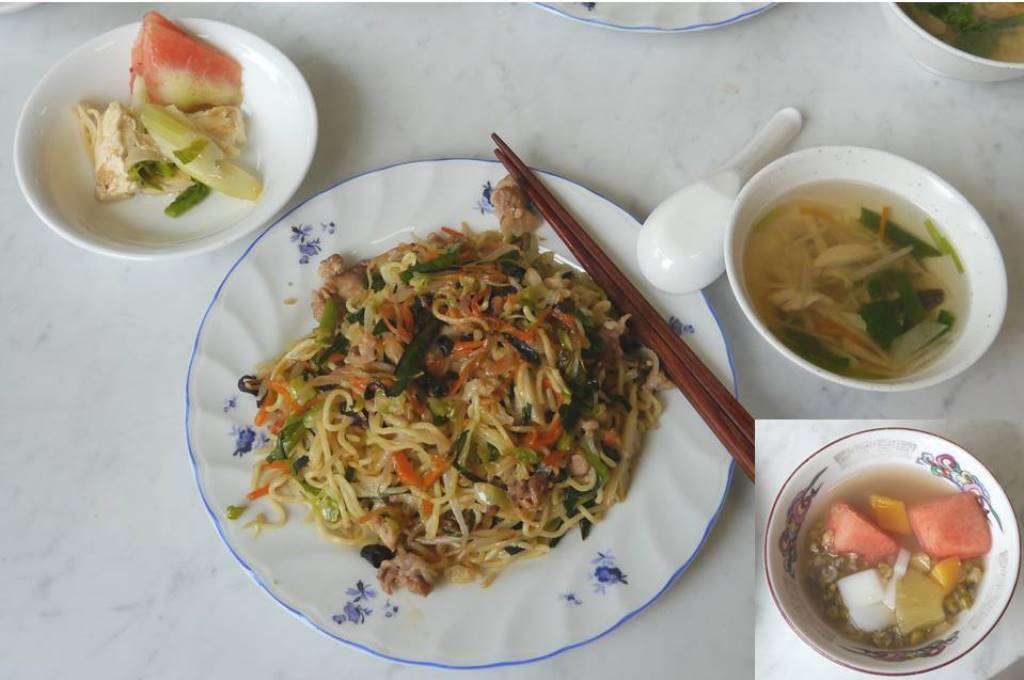
Date and Time: Thursday, May 25, 10:00 a.m. ~ 12:30 p.m.
Venue: Abista Cooking Room
Instructor: Ms. Ke Mei Ling (AIRA member-born in Taiwan)
Participants: 23 people / 18 students (6 men and 12 women) and 5 AIRA staff members (Matsuki, Komiyama, Aburano, Sakazume and Araki)
The instructor Ms. Ke, who has been living in Japan for 25 years, spoke in fluent Japanese. There was a list of ingredients but no recipe. She said, “The stir-fried noodles we’re going to cook today is my mom’s recipe and may be different from ordinary ones. Please watch my cooking first, taste it, and then, try cooking,” and the class started.
Today’s menu is stir-fried noodles, clear soup, fried tofu with celery, pickled watermelon rind and mung bean dessert.
Ms. Ke’s cooking was very skillful and the AIRA staff barely kept up with her quick actions. One of the students, Ms. Misuzu Akashi from Taiwan helped her prepare the class from early morning. The students were divided into six groups, with three people in each group.
1. First, Ms. Ke showed how to cook stir-fried noodles. Then students tasted them and started cooking in each group. The same procedure was taken for the other dishes.
The important points of cooking stir-fried noodles are;
1) to get rid of extra oil from the noodles and loosen them up by pouring hot water on them
2) to put plenty of oil when frying
3) to use sesame oil and young ginger to add flavor.
(In Taiwan ginger represents young ginger, not old one, she explained.)
And there is one more point. She used a lot of sake, which seemed to soften vegetables and enrich their taste.
While cooking, the students sometimes went to other groups and tasted their noodles, too. Noodles of each of the six groups tasted different and good.
2. As Mung bean takes long time to boil, Ms. Ke boiled all beans at her table for all the participants. This sweet paste dessert is served chilled in summer in Taiwan.
Recipe:
1) Wash beans (mung beans, broad beans, etc.) and sweet potato (or taro) and boil them together with pearl barley, which softens the other ingredients.
2) Add sugar and leave it in the refrigerator.
3) After it gets chilled, put fruit such as pineapple and watermelon, mango pudding and almond jelly with its syrup into the paste and mix them. Now it’s ready to serve!
It’s served with ice in it. In Japan we eat shaved ice topped with syrup and fruit. In Taiwan they looks like enjoying bean dessert with various kinds of toppings.
3.Fried tofu with celery is a dish for priests.
Recipe:
1) Sprinkle salt over firm tofu and leave it for a while until water comes out of it and it gets hard to break.
2) Sautee the both sides, put celery and cook more, and finally season it with salt, black pepper and a little bit of soy sauce (or ponzu, soy sauce with citrus juice.) It tastes good along with the flavor of celery.
4.Watermelon rind is usually thrown away, but Ms. Ke made refreshing and sweet pickles using it.
Recipe:
1) Peel the green outer skin of the rind and cut the white rind (It’s OK it has some red part.) diagonally into thick slices.
2) Sprinkle some salt on them and leave them for a while.
3) When water comes out of them, rinse them in water.
4) Put katsuobushi, dried bonito flakes, and ponzu, and then mix them.
The recipe is simple and it’s good for summer heat tiredness.
Finally Ms. Kitajima, vice president of AIRA made a closing speech and the class finished.
In today’s “Taiwanese Home Cooking Class”, all the students learned that, in home cooking, taste as well as ingredients can be different up to each person who cooks.
(Translated by Chizu Yamaguchi)










